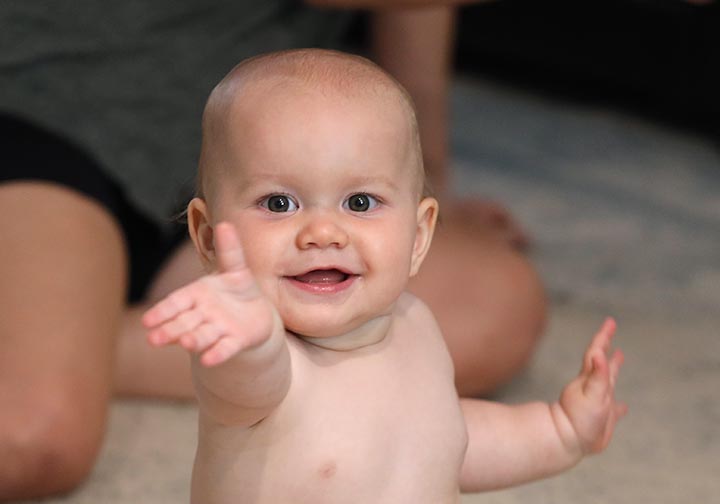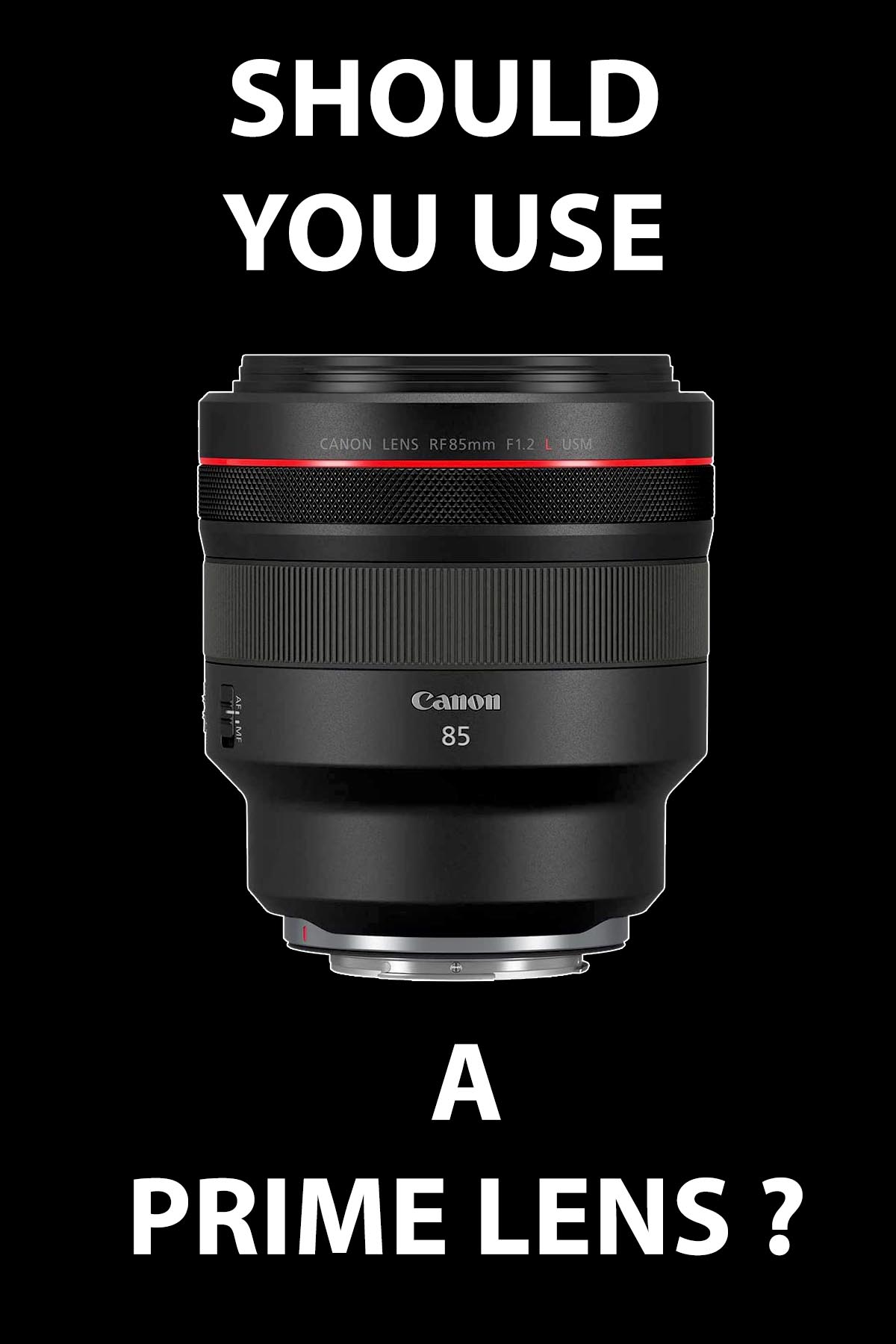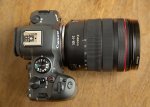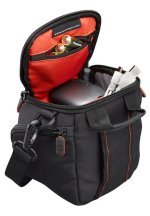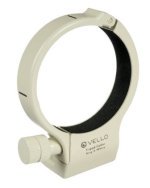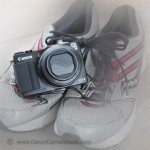Which Canon Prime Lens Is Best
WRITTEN BY: BRUCE LOVELACE
UPDATED: December 13, 2024
This page may contain affiliate links that pay me a small commission. There is no cost to you. Review the affiliate statement at the very bottom of this page if you want more information.
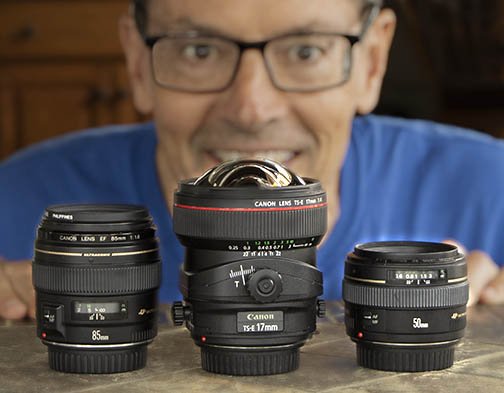 My Canon Prime Lenses
My Canon Prime Lenses85mm F/1.8 - 17mm F/4.0 Tils/Shift - 50mm f/1.4
You're wondering what prime lenses Canon has available and which Canon prime lens is best for you to get. This post is a list of lens choices, their advantages and disadvantages, and it's extensive. But first, a quick note on what it means for a lens to be called a prime lens.
what are canon prime lenses
Prime lenses come from any camera maker and do not have a zoom feature. They have a single focal length. Prime lenses range from super wide angle fisheye, to normal perspective 50mm, to super long and powerful telephoto. They also come as specialty lenses like macro and tilt-shift lenses. Canon makes them all, including some that have different versions with the same focal length.
What about the pros and cons of using a Canon prime lens?
Why You Would Want To Shoot With a Prime lens
Image quality is important and more often than not, prime lenses give you superior image quality. There are less distortions and fewer aberrations. The simpler optics make fast and sharp focusing easier to achieve. Prime lenses are smaller in dimensions, weigh less, and can be cheaper in price depending on the specific lens you use.
The biggest disadvantage of shooting with a prime lens is that they don't zoom. You have to take the time to change lenses or move your position if you want to achieve a different perspective of your subject. You also have to carry that extra lens or two with you if you want to change perspective when shooting with prime lenses.
What Photographers Shoot Photos With Prime Lenses
Nearly half of all shooters (41%) polled choose prime lenses, at least to some degree, to photograph their subjects. See the bar graph below. Generally speaking, prime lenses are faster and lighter, and have superior image quality with less distortion than zoom lenses.
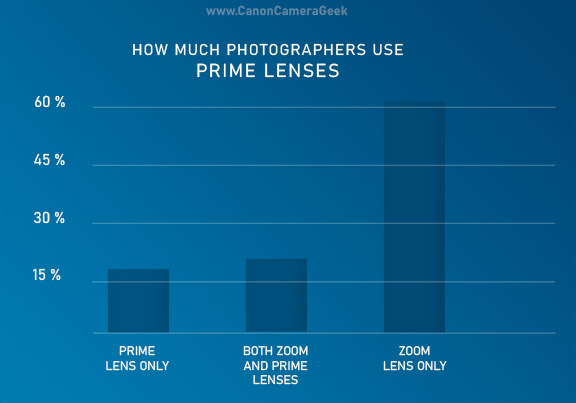 19% of photographers shoot with just prime lenses.
19% of photographers shoot with just prime lenses.20% shoot with both prime and zoom. 61% shoot with zooms.
(23,000 photographers polled at DigitalPhotographySchool)
Here is the best (and worst) Canon prime lens list for each of the three different Canon mounts, EF-S, EF, and EOS R. I've purposefully excluded Canon EF-M mounts as I've not been impressed with, nor endorse the Canon M mirrorless cameras and lenses.
Canon EF-S Prime Lenses
The first list of Canon prime lenses is the shortest. The EF-S prime lenses were designed for the smaller, "crop" APS-C cameras. Canon APS-C camera shooters are somewhat more inclined to choose the versatility and convenience of zoom lenses and don't have the same demands for the image quality of prime lenses in the smaller format.
Here are the three EF-S prime lenses:
| CANON EF-S LENS | FEATURES | AMAZON PRICE |
| Canon EF-S 24mm f/2.8 | Medium wide angle on the "crop" sized Canon APS-C camera bodies or EOS R cameras with the EOS R adapter. Super compact and light "pancake" lens makes your camera lightweight. No image stabilization, but that's not as important with wide angle lenses. | Check Price |
| Canon EF-S 35mm f/2.8 Macro IS STM | "Normal" perspective lens(56mm focal equivalent). Same compatibility as above, but in a longer focal length and capable of shooting macro photography. This prime lens does have image stabilization technology. | Check Price |
| Canon EF-S 60mm f/2.8 Macro Lens | Moderate telephoto. Same compatibility as above, but in an even longer focal length (96mm focal equivalent) and capable of shooting macro photography. Minimum focus distance of only 4 inches gives you a 1:1 macro magnification. | Check Price |
These three Canon EF-S prime lenses cover the 3 basic perspectives used in photography: wide-angle, normal, and telephoto for the APS-C crop format.
Canon EF Prime Lenses
This is where the bulk of the list of Canon prime lenses resides. Prime lenses in the EF category are more plentiful because of the demands of so many pro and advanced Canon shooters who want the best quality in their lenses.
Most of the prime Canon lenses are Canon's "L" lenses. Theses lenses will fit on both the full frame Canon bodies, the APS-C Canon bodies, as well as on the newer EOS R mirrorless bodies if coupled with the EOS R adapter.
Note that several of the focal lengths have more than 1 version. See the table of Canon EF prime lenses below.
| CANON EF LENS | FEATURES | AMAZON PRICE |
| Canon EF 14mm f/2.8 L II | A super wide lens with a super large price tag. Landscape lovers delight. Also great for astrophotography. | Check Price |
| Canon TS-E 17mm f/4L | Specialty lens for architecture. Tilt and shift abilities allow you to change the plane of focus as well as correct for the distortions and converging lines. | Check Price |
| Canon EF 24mm f/1.4 | Another super fast, very wide lens with a super large price. This lens is very highly rated by buyers and a top seller. | Check Price |
| Canon EF 35mm f/2.0 and f/1.4 L II | Medium wide angle prime. The f/2 version is not an L lens and has has a very affordable price tag. The f/1.4 II version is one stop faster and more than 3 times the cost. Both lenses are highly rated by their purchasers. | Check Price |
| Canon EF 50mm f/1.2, f/1.4, f/1.8, and f/2.8 macro | Normal perspective lens. Although all are 50mm prime lenses these nifty fifty lenses are all rather different see the full article comparing the 50mm lenses. | Check Price |
| Canon EF 85mm f/1.8 and f/1.2 L II | Medium telephoto. The original 85mm f/1.8 is the affordable NON-L version of this prime lens. The f/1.2 version is twice as fast and costs 4 times as much, but is a top choice for wedding and portrait photographers because of it performance, | Check Price |
| Canon EF 100mm f/2.8 Macro | Excellent image quality. True macro 1:1 magnification on both Canon versions of this lens. The original 100mm f/2.8 was very sharp to begin with. The newer IS version is even better. | Check Price |
| Canon EF 300mm f/4.0 L | Designed to handle the middle ground between a moderate telephoto and a super telephoto with the sharpness and performance of a Canon L lens. Used on an APS-C crop camera gives you a strong 480mm equivalent angle of view. | Check Price |
| Canon EF 400mm f/5.6 | A very affordable way to get a prime super zoom lens. Tack sharp wide open at f/5.6. Surprisingly light for a lens with this focal length. Used on an APS-C crop camera gives you a strong 640mm equivalent angle of view. | Check Price |
| Canon EF 500mm f/5.6 | It's a beast to use and it will empty out your purse or wallet. It's also a magnificent piece of glass, capable of capturing spectacular wildlife photographs. Recommend a solid tripod and capable gimbal mount. | Check Price |
Prime Lenses With Extension Tubes
Prime lenses are sharp, and when paired with one of more extension tubes, you get an additional way to use your prime lens. Simply attach an extension tube between your lens and camera body and you can shoot ultra close-ups like the busy bee photo below.
Usually, I use my 85mm prime lens for shooting macro, but I wanted to give the 50mm prime a test too. The bee in the photo above was less than 1/2 inch long and with the extension tube the prime 50 gave ma a very close minimum focusing distance.
As mentioned, Canon has more EF prime lenses than any other mount. That's clearly an advantage as the EF mount lenses can be used in place of the EF-S lenses on APS-C crop cameras, albeit with the same 1.6x crop factor. They're a perfect match for full frame Canon DSLRs too. Additionally, these EF lenses can be used on any of the full frame or crop senor EOS R mirrorless camera bodies using one of the EF-EOS R adapters.
Canon RF Prime Lenses
The Canon RF prime lenses are designed to work with the newer mirrorless Canon camera bodies and will not work with Canon DSLR cameras.
| CANON RF LENS | FEATURES | AMAZON PRICE |
| Canon RF16mm F2.8 STM | Super wide angle mirrorless. Almost as small as a "pancake" lens, great for indoors, tight spaces, as well as landscapes and scenic views. | Check Price |
| Canon RF35mm F1.8 IS Macro | Moderate wide angle on full frame and normal perspective (56mm) on crop cameras. Good focal length for street photography. Super fast at f/1.8.. | Check Price |
| Canon RF 50mm F1.8 STM | Very affordable as it's not an L lens, but still very sharp. This is the normal perspective focal length that's been around for many years. | Check Price |
| Canon RF 50mm F1.2 L UTM | It's an L lens. It's fast. It's sharp. It's pricey. Great for any situation where there is not much natural light available, including nighttime and astrophotography, where you want to shoot using a very large lens aperture. | Check Price |
| Canon RF 85mm F2 Macro is STM | Cheaper than the 100mm RF macro and much cheaper than the 85mm f/1.2. Great for portraits, both individuals and small families utilizing a nice working distance. | Check Price |
| Canon RF 85mm L F/1.2 is USM | This prime short telephoto is super fast and great focus bokeh. Much larger, heavier, and costly than the 85mm f/1.8 | Check Price |
| Canon RF 100mm F2.8 L Macro is USM | Powerful 1.4x macro magnification and a great working distance for shooting close-ups. Fair price for such great capabilities for shooting macro and portrait photography. | Check Price |
| Canon RF 400mm f/2.8 L IS USM Lens | Super telephoto focal length with Canon L image quality for sports, wildlife, and birds. Comes with a high end professional lens price tag. | Check Price |
| RF 600mm F4 L IS USM | Ultimate magnification and speed for the super serious bird, wildlife, and pro Canon sports photographers. High end professional lens with high end price and performance. | Check Price |
| Canon RF 600mm f/11 IS STM Lens | Very powerful magnification for capturing subjects big and beautiful at long distances, but with compromise. High magnification for cheap but a smaller fixed maximum aperture of f/11 | Visit Canon Store |
| Canon RF 800mm f/11 IS STM | Same as above prime lens but wit even more magnification. Ultra powerful, but with compromise. High magnification for cheap but a smaller fixed maximum aperture of f/11 | Check Price |
For a more in-depth look at the newer Canon RF line of prime lenses, see my helpful guide.
what is the sharpest canon prime lens
All Canon prime lenses are sharp. The degree of sharpness can vary from model to model. Individual lens to individual lens comparisons can reveal modest variation in sharpness. Canon L lenses are likely to be sharper than NON-L lenses because of the stringent manufacturing and modern design.
Generally speaking, the newest prime lenses are the sharpest. They benefit from using the most recent technology in design and manufacturing. For instance the EF 85mm f/1.2 L is extremally sharp, reportedly sharper than the EF 85mm f/1.4 L and the 85mm f/1.8. The newest version, the RF 85mm, should be the sharpest of all.
The most important thing to determine is whether each particular lens on your specific camera is sharp enough to satisfy YOUR needs.
The Canon Prime Lenses I Own
Here is my own collection of Canon prime lenses, also pictured at the beginning of this post.
CANON EF 50MM F/1.4. There is beauty in simplicity. The 50mm fixed focal length gives you a "normal" perspective and let's you concentrate your attention to using good compositional technique. The 50mm f/1.4 is small, it's light, and it's great for shooting in dimly lit situations.
CANON EF 85MM F/1.8. This is a great budget-priced lens with a focal length that's a good choice for shooting portraits. I've also couple this lens with my extension tubes to make it a great working macro lens.
CANON EF 17MM T/S. I rarely use this lens, but when I do it's because it's the only lens that will do the job right. You can use this tilt/shift lens to create those whimsical miniature photos like the one below. The tilt-shift lens is more often used as a professional lens for shooting interior and exterior architectural photographs without converging lines.
CANON 400MM F/5.6. This was my favorite distance lens for several years. Since, I've sold mine and upgraded to the 100-400mm f/4.5-5.6 II, but I included it here because of it's most appealing features, price and sharpness. If you aren't obsessed with having a zooming lens, the 400m f/5.6 gives you wildlife and bird photography reach, is easy to use and there are many of them in the used market for a bargain price.
The Canon Prime Lenses I'd Like To Own
Here are the Canon prime lenses I'm eyeing up at the time of this publication.
CANON RF 100MM F/2.8 MACRO. This is such a sweet lens. It's a big investment, but not nearly as pricey as the 85mm f/1.2, which is for those photographers who are overly obsessed with bokeh. The RF 100mm lens gives you a little more reach and performs amazingly well for both shooting portraits and close-up macro photography.
UPDATE: I bought one! Here are my thoughts on the RF 100mm f/2.8 L Prime Lens.
It overachieves with better than 1:1 magnification, coming in at an impressive 1.4x. The EF version of the 100mm f/2.8 lens is extremely well liked by Canon shooters and the RF version of the 100mm f/2.8 has even better optical performance. The RF 100mm prime has a great focal length for shooting portraits.
CANON RF 600MM F/4.0. This is definitely out of my price reach right now, but it would be great to own a bazooka lens like this. It's a great amount of magnification combined with a very fast f/4.0 maximum aperture for its focal length. I'd pair it up with my Canon ESO R for a great camera/lens combo for shooting birds and other wildlife.
which prime lens is best for canon
This question is frequently asked in web searches. The best choice is governed by the 3 big factors that you have to decide on for YOUR situation.
- The focal length that will give you the perspective you want.
- The version that works with your Canon camera.
- The prime lens that fits into your budget.
I truly hope you found this article helpful. Have a blast-shoot your Canon. Thanks so much!


Bruce Lovelace is the publisher of Canon Camera Geek. Read more about him on the About Page. He also publishes how to articles and camera gear reviews at the Photography Tips website.
View some of Bruce's photos on Instagram and Flickr. Join the tribe of followers on YouTube. Bruce also runs photo workshops and provides 1 on 1 digital photography coaching.
Recent Articles
-
My Review of The 10 Best Canon R6 Mark II Features That Impressed Me
Apr 12, 25 08:51 AM
Beyond the Pixel: Discover the Game-Changing Features That Make the Canon R6 Mark II a Must Have Camera -
Canon RF 24-105 Lens Comparison. Guide To Which One Is Right For You
Apr 07, 25 12:47 PM
Which is the best of the 3 versions of the Canon RF 24-105mm Lens for Canon mirrorless cameras? What's The 24-105 Lens Good For -
3 Better Alternatives to Camera Bags From Canon. Helpful Guide To Bags
Apr 03, 25 11:51 AM
After searching for the top best selling Canon bags, I found 3 better alternatives to camera bags from Canon -
Canon 70-200 2.8 Tripod Collar. Article and Video of The Advantages
Apr 03, 25 11:02 AM
Some call it an optional accessory. I say a canon 70-200 2.8 tripod collar is a necessity when using this lens on a tripod or monopod. -
Running With The G1X Mark II, Acting Like a Kid, You Should Try This
Apr 03, 25 10:31 AM
Ever get a new "toy" and want to just play? I did.Got my new Canon compact camera. Went running with the G1x Mark II
This page may contain affiliate links that pay me a small commission. There is no cost to you. Review the affiliate statement at the very bottom of this page if you want more information.


